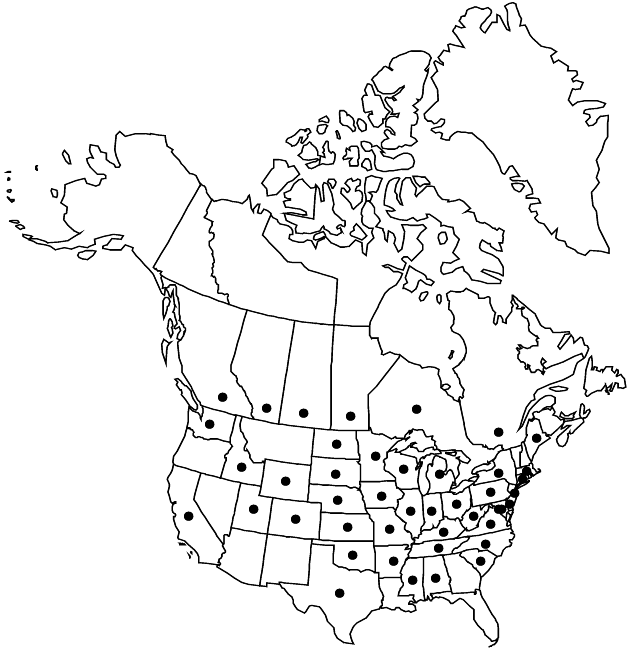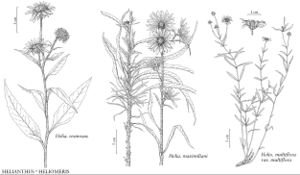Difference between revisions of "Helianthus maximiliani"
Index Seminum (Göttingen) 1834: unpaged. 1835.
FNA>Volume Importer |
imported>Volume Importer |
||
| (3 intermediate revisions by 2 users not shown) | |||
| Line 8: | Line 8: | ||
}} | }} | ||
|common_names=Maximilian sunflower;hélianthe de Maximilien | |common_names=Maximilian sunflower;hélianthe de Maximilien | ||
| + | |special_status={{Treatment/ID/Special_status | ||
| + | |code=F | ||
| + | |label=Illustrated | ||
| + | }} | ||
|basionyms= | |basionyms= | ||
|synonyms={{Treatment/ID/Synonym | |synonyms={{Treatment/ID/Synonym | ||
|name=Helianthus dalyi | |name=Helianthus dalyi | ||
|authority=Britton | |authority=Britton | ||
| + | |rank=species | ||
}} | }} | ||
|hierarchy=Asteraceae;Asteraceae tribe Heliantheae;Asteraceae (tribe Heliantheae) subtribe Helianthinae;Helianthus;Helianthus maximiliani | |hierarchy=Asteraceae;Asteraceae tribe Heliantheae;Asteraceae (tribe Heliantheae) subtribe Helianthinae;Helianthus;Helianthus maximiliani | ||
| Line 36: | Line 41: | ||
-->{{#Taxon: | -->{{#Taxon: | ||
name=Helianthus maximiliani | name=Helianthus maximiliani | ||
| − | |||
|authority=Schrader | |authority=Schrader | ||
|rank=species | |rank=species | ||
| Line 50: | Line 54: | ||
|publication title=Index Seminum (Göttingen) | |publication title=Index Seminum (Göttingen) | ||
|publication year=1835 | |publication year=1835 | ||
| − | |special status= | + | |special status=Illustrated |
| − | |source xml=https:// | + | |source xml=https://bitbucket.org/aafc-mbb/fna-data-curation/src/2e0870ddd59836b60bcf96646a41e87ea5a5943a/coarse_grained_fna_xml/V19-20-21/V21_401.xml |
|tribe=Asteraceae tribe Heliantheae | |tribe=Asteraceae tribe Heliantheae | ||
|subtribe=Asteraceae (tribe Heliantheae) subtribe Helianthinae | |subtribe=Asteraceae (tribe Heliantheae) subtribe Helianthinae | ||
Latest revision as of 20:12, 5 November 2020
Perennials, 50–300 cm (rhizomatous). Stems erect, 5–30 dm, scabrous to scabro-hispidulous. Leaves cauline; mostly alternate; petioles 0–2 cm; blades (light green to gray-green, 1-nerved, conduplicate) lanceolate, 10–30 × 2–5.5 cm, bases cuneate, margins usually entire, sometimes serrulate, abaxial faces scabrous to scabro-hispid, gland-dotted. Heads (1–)3–15 (often in racemiform to spiciform arrays). Peduncles 1–11 cm. Involucres hemispheric, 13–28 mm diam. Phyllaries 30–40, lanceolate, 14–20 × 2–3 mm, (margins ciliate) apices acute to attenuate, abaxial faces canescent, gland-dotted. Paleae 7–11 mm, entire or 3-toothed (apices greenish, mucronate, hairy). Ray florets 10–25; laminae (15–)25–40 mm. Disc florets 75+; corollas 5–7 mm, lobes yellow; anthers dark brown or black; appendages usually yellow, sometimes partly dark. Cypselae 3–4 mm, glabrate; pappi of 2 aristate scales 3–4.1 mm. 2n = 34.
Phenology: Flowering late summer–fall.
Habitat: Prairies, fields, waste areas
Elevation: 0–300(–2100+) m
Distribution

Alta., B.C., Man., Ont., Que., Sask., Ala., Ark., Calif., Colo., Conn., Del., D.C., Idaho, Ill., Ind., Iowa, Kans., Ky., Maine, Md., Mass., Mich., Minn., Miss., Mo., Nebr., N.J., N.Y., N.C., N.Dak., Ohio, Okla., Pa., S.C., S.Dak., Tenn., Tex., Utah, Va., Wash., W.Va., Wis., Wyo., Mexico.
Discussion
Helianthus maximiliani is introduced in eastern Ontario and in Quebec. It appears to be native to midcontinental prairie regions and has spread along railroads and highways into all areas of North America. Its wide dispersal may be aided by cultivation for its attractive, showy floral displays. In addition to the usually conduplicate, single-nerved leaves and spikelike arrangement of the heads, it is distinguished by the whitish-canescent indument of the leaves and stems and the long-attenuate phyllaries.
Selected References
None.
